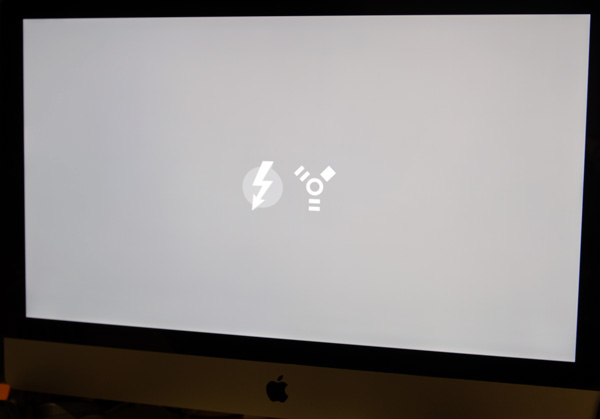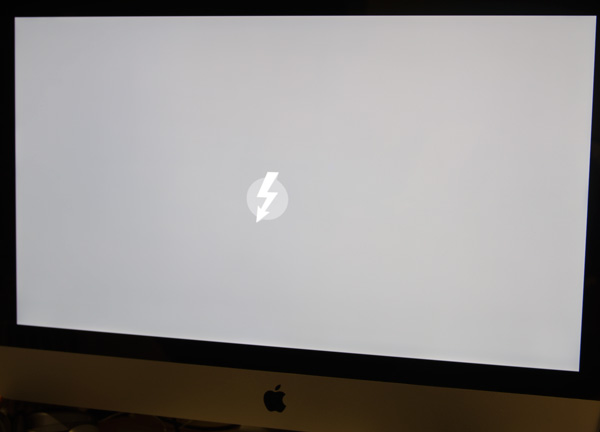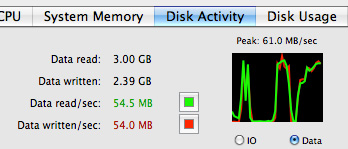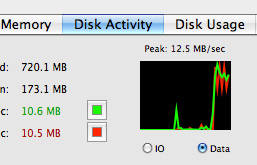Promise Pegasus R6 & Mac Thunderbolt Review
by Anand Lal Shimpi on July 8, 2011 2:01 AM ESTTarget Disk Mode
Another use of Thunderbolt is Target Disk Mode. Connect any two 2011 iMacs, 2011 MacBook Pros or any combination of the two with a Thunderbolt cable, reboot one of them while holding down the T key and you'll boot into target disk mode.

Hold down T and you'll get both Thunderbolt and FireWire logos at boot

With only Thunderbolt connected, the FireWire logo disappears - you're now in Target Disk Mode over TB
In this mode the target Mac boots into a special EFI state that allows all of its drives (HDDs, SSDs, optical, anything connected to the computer) to be mounted by the host Mac. The drives appear like normal removable disks on the host Mac:

MacBook Pro accessing the iMac's sole HDD over Thunderbolt in Target Disk Mode
You even have to eject them all manually before turning off the target Mac.
Don't get too excited though, since the target Mac isn't running full blown OS X it only implements basic storage drivers and optimizations. As a result, peak performance is no where near what Thunderbolt is capable of. Regardless of whether I put the 15-inch MacBook Pro or 27-inch iMac in target disk mode, I never saw more than 61MB/s from the target.

Performance was erratic as well. Sometimes I'd see transfer rates drop all the way down to 9MB/s before jumping up to 30MB/s and then 60MB/s. On average I'd say I saw transfers around 40MB/s.

The functionality is great, however I believe target disk mode would be a killer feature of Thunderbolt if it could operate at peak performance. In its current implementation, it's faster than a WiFi transfer but a bit slower than a good Gigabit Ethernet network transfer. If we could get line speed transfers, being able to move data between two modern Macs at multiple Gbps would be great.










88 Comments
View All Comments
darwinosx - Friday, July 8, 2011 - link
Hardly anyone uses projectors so VGA ports should only be on business class laptops.Zok - Friday, July 8, 2011 - link
Can't say I agree with you there. Despite being issued a corporate laptop, I use my personal one for most of my work, including (VGA-requisite) projector presenting.cacca - Friday, July 8, 2011 - link
some questions:Does USB 3 port do the same?
Does the PCI-E external do the same?
Does External SATA do the same?
Thunderbolt is just another PROPRIETARY standard that competes with others.
It reminds me RAMBUS.
were cost and compatibility matters. Is faster but....
We will ever seen a review of something from Intel that points out the shortcomings?
or this place is ADDtech instead of anandtech?
André - Friday, July 8, 2011 - link
Rest assured that USB 3.0 does NOT in any way or form do the same as Thunderbolt.The protocols are very different, as in, USB 3.0 nearly doesn't support any and Thunderbolt being an extension of a 4 x PCI-Express slot does support heaps of features, like Target Disk Mode, S.M.A.R.T.-status, Native Command Queuing, daisy-chaining (with very low latency) making it ideal for many professional applications (Audio/Visual devices), bi-directional bandwidth, DisplayPort, 10 Watt of power and native software driver support.
Just to name a few.
External SATA doesn't do the same either.
Thunderbolt is a multi-purpose connector, not limited to only storage or transfer of files.
If you for a minute think that USB or E-SATA does the same as Thunderbolt, then you need to educate yourself.
It has the potential to replace all other external connectors. One cable to rule them all, instead of legacy cables that clutter up the backside of your computer and collect dust.
Anato - Friday, July 8, 2011 - link
And one controller (maker) to rule us all. Thats a big problem in PC, but not necessarily in Mac.Jaybus - Sunday, July 10, 2011 - link
Not really. Light Peak is essentially protocol agnostic. It tunnels PCI-E. The PCI-E-to-whatever bridge is built into the cable and/or dongle. In other words, a USB 3.0 adapter/hub that plugs into a Light Peak port is possible and even likely.While Intel may control the Light Peak controller, which will no doubt be integrated into motherboard chipsets, I don't think that will give them a monopoly on the bridge chips that make LP actually useful.Exodite - Friday, July 8, 2011 - link
Cue 'potential'.It's not hard to foresee another Firewire or mini-DP in the making, or a Beta if you prefer going old-school.
Coupling Light Peak technology with mini-DP was a mistake. The technology is new, unproven and offers precious few usage scenarios with non-existent device support. Piggy-backing it on mini-DP, which suffer from pretty much exactly the same issues, won't help adoption rates.
Choosing USB over mini-DP as the 'legacy' interface would have been a much better choice.
André - Friday, July 8, 2011 - link
Except that the USB connector is only allowed to be used as an USB connector.DisplayPort is also vastly superior to any other display cable standard, so I cannot see the problem in that regard. Mini-Display is already shipping in millions and millions of computers, as well as Mini-DisplayPort. The same can be said by Thunderbolt, even though it is only Apple who have fully embraced the technology.
As a professional in the audio/visual segment I can hardly see the problem with it being a repeat of FireWire, because my market usually adopts the better technology despite of a small price increase. Of course, it helps that we only use Apple computers to begin with and have already ditched all the back-alley, legacy connectors.
Uritziel - Friday, July 8, 2011 - link
Heh, yet another continuation of the myth that media professionals only use macs...André - Friday, July 8, 2011 - link
Kindly don't put words in my mouth ;)I didn't say media professionals only use Apple computers, I said my company only use them.
As for now it only makes sense to discuss Thunderbolt and Apple computers as Apple are the only ones who has it currently.
But you just have to look at the companies that are releasing Thunderbolt enabled devices to understand that this connector is really something professionals are going to use. Next year the market will open up when PC vendors finally, if they so choose, to embrace the technology.